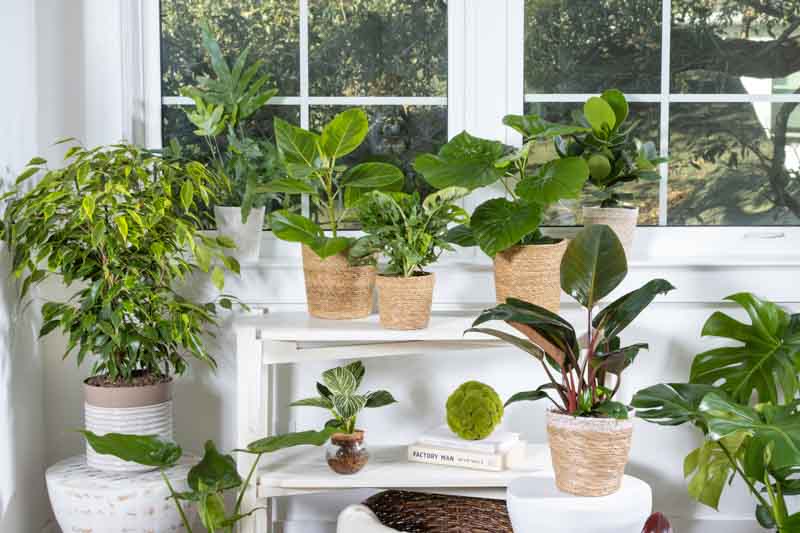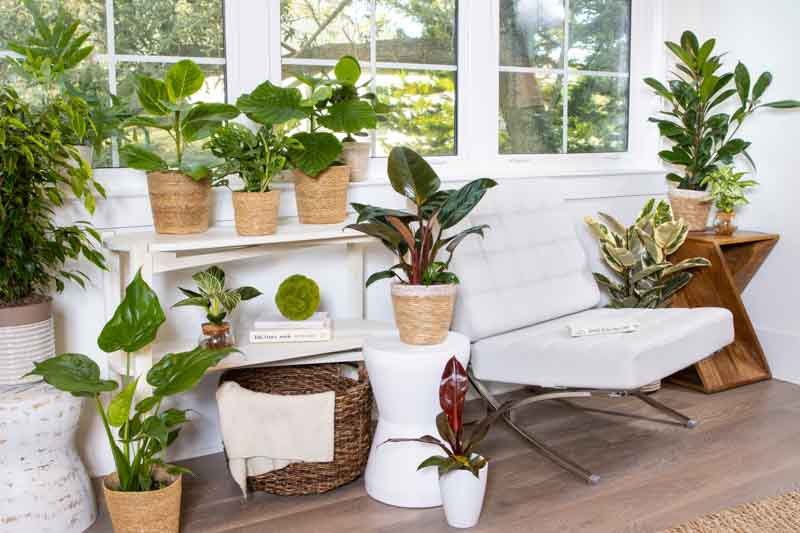Philodendron 'Rojo Congo', Philodendron tatei ‘Rojo Congo’
Philodendron ‘Rojo Congo’ is a standout variety within the Philodendron genus, celebrated for its unique coloration and robust growth. This hybrid combines the ease of care associated with philodendrons with distinctive aesthetic appeal, making it a favored choice for both novice and experienced plant enthusiasts.
Philodendron ‘Rojo Congo’ is known for its striking, glossy leaves that emerge a vibrant red or burgundy and mature into a deep green with red to purple hues on the undersides. The plant’s sturdy, upright stems are also tinged with red, adding to its overall vibrant appearance. Its leaves are large, broad, and spear-shaped, contributing to a lush, tropical look.
Native: Philodendrons are native to the tropical regions of the Americas and the Caribbean. These plants are accustomed to the warm, humid environments of rainforests. They belong to the arum family (Araceae), along with Zantedeschia (Calla Lily), Caladium (Angel Wing), Monstera (Swiss Cheese Plant), or Colocasia (Elephant Ear).
Plant Type and Habit: Philodendron ‘Rojo Congo’ is a self-heading Philodendron, meaning it grows upright and does not vine or climb in the manner of some other philodendrons. The growth habit of this evergreen perennial makes it particularly suitable for indoor settings where space may be limited, as it tends to expand vertically rather than horizontally.
Size: Typically, ‘Rojo Congo’ can reach 2-3 feet in height indoors (60-90 cm), with a similar spread. Its growth is relatively fast under optimal conditions, allowing it to become a substantial presence in any room quickly.
Foliage: The foliage of ‘Rojo Congo’ is undoubtedly its most compelling feature. The leaves are not only large and eye-catching but also have a rich, waxy sheen that reflects light beautifully. The transition of leaf color from red to deep green as they mature creates a dynamic display of color within the plant itself.
Hardiness: If planted outdoors, this plant is hardy in USDA zones 10-12. It is best suited to indoor environments where temperatures can be kept consistent, ideally between 60-85°F (15-29°C). It is not frost-tolerant and should be protected from cold drafts.
Uses: Philodendron ‘Rojo Congo’ is primarily used for ornamental purposes. Its bold coloration and architectural form make it an excellent choice for adding a touch of the tropics to interior spaces.
Toxicity: Philodendrons are toxic to humans, cats, and dogs if ingested. They contain calcium oxalate crystals that can cause mouth and stomach irritation. Contact with the sap may cause skin irritation.
Benefits: Beyond its decorative value, it also serves as an air purifier, improving indoor air quality by filtering out certain toxins. It’s well-suited for placement in living rooms, offices, or any space that could benefit from a splash of vivid greenery.

Light: Rojo Congo Philodendronn prefers bright, indirect light to maintain its unique coloring. Avoid direct sunlight, which can scorch their leaves.
Soil: Use a well-draining, peat-based potting mix. Rojo Congo Philodendron prefers slightly acidic to neutral pH levels. Ensure the pot has drainage holes to prevent water from accumulating at the bottom.
Water: Water your Rojo Congo Philodendron when the top inch of soil feels dry to the touch. Over-watering can lead to root rot, so ensure proper drainage.
Temperature and Humidity: Ideal temperatures range between 60°F and 85°F (15°C to 29°C). Protect it from cold drafts and temperatures below 55°F (13°C), as it is not cold-hardy. Thrives in higher humidity but can adapt to average home humidity levels. For drier environments, consider using a humidifier or placing the plant on a pebble tray with water to increase surrounding moisture.
Fertilization: Fertilize monthly during the growing season (spring and summer) with a balanced, water-soluble fertilizer, diluted to half the recommended strength. Reduce feeding in fall and winter.
Pruning: Prune as needed to remove any yellow or damaged leaves and to encourage bushier growth. Use clean, sharp scissors or pruning shears to make clean cuts.
Repotting: Repot every 2-3 years or when the plant becomes root-bound. Spring is the ideal time to repot, choosing a pot only slightly larger than the previous one to avoid excess soil moisture.
Propagating Philodendron plants is a straightforward and rewarding process, allowing you to expand your collection or share with friends and family. The most common method is stem cuttings, which can be rooted in water or soil. Here’s how to do it:
Choose a Healthy Stem: Look for a healthy stem with at least 2-3 leaves and a few nodes (the points on the stem where leaves attach and roots tend to grow).
Make the Cut: Using a clean, sharp knife or scissors, cut just below a node. The cutting should be about 4-6 inches long.
Prepare the Cutting: Remove any leaves that would be submerged when you place the stem in water to prevent rot.
Root in Water: Place the cutting in a glass or jar of water, ensuring the node is submerged. Leave the leaves out of the water. Place the jar in a warm, bright spot with indirect light.
Change the Water Regularly: Refresh the water every few days to keep it clean, which helps prevent bacterial growth.
Wait for Roots: Roots should start to emerge from the nodes in about 2-4 weeks. Wait until the roots are a few inches long before potting.
Potting: Once the roots are sufficiently developed, plant the cutting in a pot with well-draining soil. Care for it as you would a mature Philodendron.
Prepare Your Cutting: Follow the same steps as above to select and cut a healthy stem section.
Rooting Hormone (Optional): Dip the cut end of the stem in rooting hormone powder to encourage root growth. This step is optional but can enhance rooting success.
Plant the Cutting: Fill a pot with a well-draining potting mix. Make a hole in the center and insert the cut end of the stem, ensuring at least one node is buried beneath the soil surface.
Water and Cover: Water the soil lightly to settle it around the cutting. To create a humid microenvironment, you can cover the pot with a plastic bag or place it in a propagator. Ensure the leaves are not touching the plastic to prevent rot.
Care for Your Cutting: Place the pot in a warm, bright location with indirect light. Keep the soil consistently moist but not waterlogged.
Wait for Growth: In a few weeks, the cutting should start to root. You can gently tug on the plant after about 4 weeks; if there’s resistance, roots have formed.

Philodendrons can encounter pests, diseases, and other common problems, especially when grown indoors.
Spider Mites: These tiny pests can be identified by the fine webs they weave on the plant. They cause yellowing or speckled leaves. Increase humidity around the plant and wash it with a strong stream of water. For severe infestations, use insecticidal soap or neem oil.
Mealybugs: These white, cottony pests tend to cluster in leaf axils and under leaves, sucking sap and weakening the plant. Remove with alcohol-dipped cotton swabs or apply neem oil.
Aphids: Small, soft-bodied insects that can be green, black, brown, or pink, aphids typically feed in groups on the undersides of leaves. Combat them with a gentle spray of water, neem oil, or insecticidal soap to protect the plant’s health and appearance.
Scale insects: Hard or soft-bodied insects that attach themselves to the stems or leaves, causing yellowing and growth stunting. Scrape off with a fingernail or use a cotton swab dipped in rubbing alcohol. Insecticidal soap or neem oil may also be used.
Root rot: Overwatering is the primary cause, leading to brown, mushy roots and yellowing leaves. Reduce watering, improve drainage, and repot the plant into fresh, well-draining soil. Severely affected roots should be trimmed before repotting.
Leaf spot: Fungal or bacterial infections can cause dark or black spots on leaves, often with a yellow halo. Increase air circulation, avoid wetting leaves when watering, and remove affected leaves. Fungicides or bactericides may be necessary in severe cases.
Yellowing Leaves: Often a sign of overwatering or poor drainage. Ensure the plant is in well-draining soil and adjust your watering schedule to allow the soil to dry slightly between waterings.
Brown Leaf Tips: Can indicate low humidity, especially in dry indoor environments. Increase humidity around the plant with a humidifier, pebble tray, or by misting the leaves regularly.
Leaf Scorch: Direct sunlight can cause the leaves to scorch, leading to brown patches or fading of the vibrant leaf colors. Position the plant in a location where it receives bright, indirect light.
Drooping Leaves: This can be a sign of both underwatering and overwatering. Check the soil moisture to determine the cause and adjust your watering accordingly.
Slow Growth or Lack of Color: Insufficient light can lead to less vibrant leaf coloration and slow growth. Ensure your Rojo Congo is receiving enough indirect light to maintain its rich hues and promote healthy growth.
| Hardiness |
10 - 12 |
|---|---|
| Plant Type | Houseplants, Perennials |
| Plant Family | Araceae |
| Genus | Philodendron |
| Exposure | Partial Sun |
| Season of Interest |
Spring (Early, Mid, Late) Summer (Early, Mid, Late) Fall Winter |
| Height |
2' - 3' (60cm - 90cm) |
| Spread |
2' - 3' (60cm - 90cm) |
| Maintenance | Low |
| Water Needs | Average |
| Soil Type | Loam, Sand |
| Soil pH | Acid, Neutral, Alkaline |
| Soil Drainage | Moist but Well-Drained |
| Characteristics | Showy, Evergreen |
| Tolerance | Deer, Rabbit |
| Garden Uses | Patio And Containers |
| Hardiness |
10 - 12 |
|---|---|
| Plant Type | Houseplants, Perennials |
| Plant Family | Araceae |
| Genus | Philodendron |
| Exposure | Partial Sun |
| Season of Interest |
Spring (Early, Mid, Late) Summer (Early, Mid, Late) Fall Winter |
| Height |
2' - 3' (60cm - 90cm) |
| Spread |
2' - 3' (60cm - 90cm) |
| Maintenance | Low |
| Water Needs | Average |
| Soil Type | Loam, Sand |
| Soil pH | Acid, Neutral, Alkaline |
| Soil Drainage | Moist but Well-Drained |
| Characteristics | Showy, Evergreen |
| Tolerance | Deer, Rabbit |
| Garden Uses | Patio And Containers |
How many Philodendron Prismacolor™ Rojo Congo do I need for my garden?
| Plant | Quantity | |
|---|---|---|
| Philodendron Prismacolor™ Rojo Congo | N/A | Buy Plants |
Create a membership account to save your garden designs and to view them on any device.
Becoming a contributing member of Gardenia is easy and can be done in just a few minutes. If you provide us with your name, email address and the payment of a modest $25 annual membership fee, you will become a full member, enabling you to design and save up to 25 of your garden design ideas.
Join now and start creating your dream garden!
Create a membership account to save your garden designs and to view them on any device.
Becoming a contributing member of Gardenia is easy and can be done in just a few minutes. If you provide us with your name, email address and the payment of a modest $25 annual membership fee, you will become a full member, enabling you to design and save up to 25 of your garden design ideas.
Join now and start creating your dream garden!